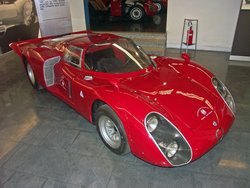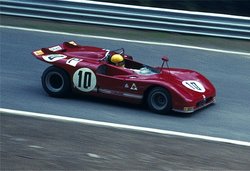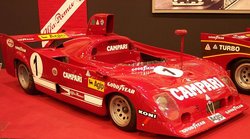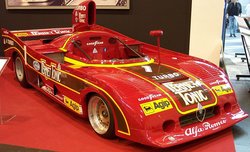Alfa Romeo Tipo 33
The Alfa Romeo Tipo 33 was a sports racing prototype raced by the Alfa Romeo works team between 1967 and 1977. These cars took part for Sport Cars World Championship, Interserie and CanAm series. A small number of road going cars were derived from it in 1967, called Alfa Romeo 33 Stradale.
Alfa Romeo Tipo 33
Alfa Romeo started development of Tipo 33 in early 1960s, first car being built in 1965. First version was sent to 1963 established Autodelta to be finished and for additional changes. First car was using Alfa Romeo TZ2 straight-4 engine. But soon Autodelta finished its 2.0 litre V8. The 2000 cc (122ci) Tipo 33 mid-engined prototype debuted on 12 March 1967 at the Belgian hillclimbing event at Fléron, with Teodoro Zeccoli winning. The first version was named as “periscope” because it had very characteristic air inlet. It was powered by a 1995 cc (122ci) 90° V8 of 270hp (201kW), with a large-diameter tube frame. The original T33 proved unreliable and uncompetitive in the World Sportscar Championship, its best result a 5th at the Nürburgring 1000, co-driven by Zeccoli and Roberto Bussinello.
Alfa Romeo 33/2

| |
| Alfa Romeo 33/2 | |
|---|---|
| Aka | |
| Manufacturer | Alfa Romeo |
| Parent company | |
| Production | 1967-1968 |
| Class | Race car |
| Platform | |
| Layout | RMR layout |
| Engine | 1995cc V8 270bhp @ 9600rpm 2500cc V8 315bhp |
| Transmission | |
| Suspension | |
| Weight | 580 kg (1278 lb |
| Designer | Autodelta |
In 1968, Alfa's subsidiary, Autodelta, created an evolution model called 33/2. A road version, dubbed Alfa Romeo 33 Stradale, was also introduced. At the 24 Hours of Daytona, the Porsche 907 with 2.2L engines were dominating the overall race, but Alfa took the 2-litre class win, with Udo Schütz and Nino Vaccarella,after that the car was named as "Daytona". Win was repeated at the Targa Florio, where Nanni Galli and Ignazio Giunti also took second place overall, followed by teammates Lucien Bianchi and Mario Casoni. Galli and Giunti then won the class at the Nürburgring 1000km, where the 2.5L version finished for the first time, 4th place in the 3.0L class with Schütz and Bianchi. However, in most races, the Alfa drivers were outclassed by their Porsche rivals which used bigger engines. In 1968, the car was used mainly by privateers, winning its class in the 1000km Monza, Targa Florio and Nürburgring races. At the end of season 1968 Alfa Romeo finished third in the manufacturers championship.
Alfa Romeo 33/3

| |
| Alfa Romeo 33/3 Alfa Romeo 33TT3 | |
|---|---|
| Aka | Alfa Romeo |
| Manufacturer | Alfa Romeo |
| Production | 1967-1971 |
| Class | Race car |
| Platform | |
| Layout | RMR layout |
| Engine | 2998cc V8 400bhp @ 9000rpm 440bhp @ 9800rpm |
| Transmission | |
| Suspension | |
| Steering | |
| Brakes | |
| Weight | 700 kg/650 kg (1971) (1543 lb)/(1433 lb) (1971) |
| Designer | Autodelta |
In 1969 at the 12 Hours of Sebring, the Alfa Romeo 33/3 made its debut. The engine was enlarged to 2998 cc (183ci) with 400hp (298kW), which put the 33/3 in the same class as the Porsche 908 and the Ferrari 312P. The chassis was now a monocoque.
The Sebring race was very bad for the new car and Alfa did not took part for Le Mans because Bianchi died tragically in a crash in practising session. The car took couple of wins in smaller competitions but the season 1969 was not overall good the team was again
third in the championship.
After a dismal 1969, in 1970, the bigger 5.0L Porsche 917 and Ferrari 512 dominated, yet Toine Hezemans and Masten Gregory took third overall at Sebring, and Andrea De Adamich and Henri Pescarolo won their class in the 1000km Zeltweg, finishing second overall. Also in 1970, an Alfa T 33/3 was one of the "actors" of Steve McQueen's movie Le Mans, released in 1971.
In 1971, the Alfa Romeo racing effort was finally successful. Rolf Stommelen and Nanni Galli won their class at the 1000km Buenos Aires (followed by De Adamich and Pescarolo), before taking another class win (and second overall) at Sebring. De Adamich and Pescarolo later won outright at the 1000km Brands Hatch, a significant against the "invincible" 917s. They were then taking a class win at Monza (where Alfa Romeo took the three podium slots in the prototype class) and another one at Spa. At the Targa Florio, Vaccarella and Hezemans won outright, followed by teammates De Adamich and Gijs Van Lennep. Hezemans and Vaccarella won their class at Zeltweg, and De Adamich and Ronnie Peterson won overall at Watkins Glen. Season 1971 Alfa Romeo finished with second place in the championship.
1972 and 1973
In these years, the 5L sports car were banned. The 3L cars of Alfa, the Ferrari 312PB and the Matra challenged for outright victories now.
Alfa Romeo T33/4
A 4 litre version was entered to 1972 and 1974 CanAm series by Otto Zipper, driver was Scooter Patrick. Autodelta was also one of entrants with T33/4 in season 1974. T33/3 version was also used in CanAm series earlier. The 33/4 was used later in Australia's Tasman Cup driver was Graham Lawrence.[1] Car had different body style and was dubbed as "Tasman Coupe".
Alfa Romeo 33TT12
| Alfa Romeo 33TT12 | |
|---|---|
| Aka | |
| Manufacturer | Alfa Romeo |
| Production | 1973-1976 |
| Class | Race car |
| Platform | |
| Layout | RMR layout |
| Engine | 2995cc F12 500bhp @ 11000rpm |
| Transmission | |
| Suspension | |
| Weight | 670 kg (1477 lb) |
| Designer | Autodelta |
1973 was introduced 33 TT 12 (Telaio Tubolare, tubular chassis) which had Carlo Chiti-designed 12 cylinder 3.0L flat engine (500 bhp). Season 1973 was more or less development time and in 1974 the car took win at Monza 1000 km and finished the season with second place in the championship. It wasn’t until 1975 when after years of trying Alfa Romeo won sport cars world championship. The season was almost total domination, seven wins in eight races. Winning drivers were: Arturo Merzario, Vittorio Brambilla, Jacques Laffite, Henri Pescarolo, Derek Bell and Jochen Mass. For 1976 Autodelta was concentrating other things and the car was rarely used in competitions.
Alfa Romeo 33SC12
| Alfa Romeo 33SC12 Alfa Romeo 33SC12 Turbo | |
|---|---|
| Manufacturer | Alfa Romeo |
| Production | 1977 |
| Class | Race car |
| Layout | RMR layout |
| Engine(s) | 2993cc F12 520bhp @ 12000rpm 2134cc F12 640bhp @ 11000rpm |
| Curb weight | 720 kg (1587 lb) |
| Designer | Autodelta |
As a successor of the 33TT12 1977 appeared the 33SC12, SC referring for SCatolato a boxed chassis. 3.0 L flat-12 engine had now 520 bhp. With this car Alfa Romeo won again the sports car world championship in 1977. The SC12 won every race on that season, winning drivers were: Arturo Merzario, Jean-Pierre Jarier and Vittorio Brambilla. On the Salzburg ring the car reached an average speed of 203,82 km/h, on that same race was also tested 2134 cc turbocharged SC12 producing 640 bhp, Arturo Merzario finished second with that car. The SC12 Turbo was Alfa's first twin turbocharged V12-engine and it was introduced around same time as Renault's Formula One turbo engine. In Alfa Romeo engine both engine rows were fed with own turbocharger, that feature was followed by many racecar makers in the following years.
Engine was later used on Brabham-Alfa BT 45, BT46 and Alfa Romeo 177 F1 cars.
External links
- Alfa Romeo T33, striking example for the use of Rosso Corsa
- Alfa Website also with Racing with History
- World Sportscar Championship 1968 results
- World Sportscar Championship 1977 results
- World Sportscar Championship 1975 results
- 1972 Racing season Alfa vs. Ferrari
- Can-Am Championship results
| <- Previous | Alfa Romeo Automobiles S.p.A., a subsidiary of the Fiat S.p.A. since 1986, car timeline, 1946-1979 | Next -> | ||||||||||||||||||||||||||||||||||||||||||
| Type | 1950s | 1960s | 1970s | |||||||||||||||||||||||||||||||||||||||||
| 0 | 1 | 2 | 3 | 4 | 5 | 6 | 7 | 8 | 9 | 0 | 1 | 2 | 3 | 4 | 5 | 6 | 7 | 8 | 9 | 0 | 1 | 2 | 3 | 4 | 5 | 6 | 7 | 8 | 9 | |||||||||||||||
| Small family car | Dauphine* | Alfasud | ||||||||||||||||||||||||||||||||||||||||||
| Compact executive car | Giulietta (750/101) | |||||||||||||||||||||||||||||||||||||||||||
| Giulia | Giulietta (116) | |||||||||||||||||||||||||||||||||||||||||||
| 1750 | Alfetta | |||||||||||||||||||||||||||||||||||||||||||
| Executive car | 1900 | 2000 | 2600 | 2000 | Alfa 6 | |||||||||||||||||||||||||||||||||||||||
| Cabriolet | 1900 | 2000 | 2600 | |||||||||||||||||||||||||||||||||||||||||
| Coupé | Giulietta | Sprint | ||||||||||||||||||||||||||||||||||||||||||
| Giulia | Alfetta GT/GTV and GTV6 | |||||||||||||||||||||||||||||||||||||||||||
| 1900 | 2000 | 2600 | ||||||||||||||||||||||||||||||||||||||||||
| Roadster | Spider | |||||||||||||||||||||||||||||||||||||||||||
| Gran Sport Quattroruote | ||||||||||||||||||||||||||||||||||||||||||||
| Sports car | …6C 2500 | Montreal | ||||||||||||||||||||||||||||||||||||||||||
| 33 Stradale | ||||||||||||||||||||||||||||||||||||||||||||
| Off-road | Matta | |||||||||||||||||||||||||||||||||||||||||||
| Racing car | TZ/GTA | |||||||||||||||||||||||||||||||||||||||||||
| …158/159 | Tipo 33 | 177 | ||||||||||||||||||||||||||||||||||||||||||
| *Dauphine was produced under Renault license | ||||||||||||||||||||||||||||||||||||||||||||


